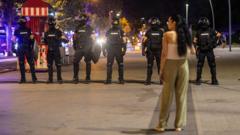As the ninth month of anti-corruption protests in Serbia unfolds, demonstrators are adopting new strategies, diverging from their previous format of large rallies. The movement has been marked by a decisive turn as student leaders, who previously spearheaded the demonstrations from their inception in November, have announced that they will no longer take the lead. Following a significant protest last weekend that drew around 140,000 participants in Belgrade’s Slavija Square, these students set a deadline for the government to schedule fresh elections. Since the deadline passed without action from President Aleksandar Vucic's administration, they have invited other groups to take part in a "civil disobedience" campaign against the long-standing ruling party, the Progressive Party (SNS).
The atmosphere has quickly transformed, giving rise to roadblocks in multiple Serbian cities, where citizens utilize everyday items like dustbins and chairs to impede traffic at key junctions. Neighborhood residents and local organizations, referred to as "citizens' assemblies," have significantly participated in this movement. Despite police efforts to dismantle these blockades, new ones continue to sprout, demonstrating the resolve of the protestors.
The ongoing police response has sparked significant backlash. Numerous arrests have occurred, along with reports of excessive force used by law enforcement. A disturbing incident on Wednesday involving Gendarmerie officers at Belgrade University's Law Faculty left several students injured and prompted protests from parents demanding their children's release after the detention of high school students. Widely condemned by various factions, including journalists, opposition parties, and even the Serbian Orthodox Church, the police’s actions have drawn the attention of the European Union, which criticized the violence.
While travel chaos ensues amid the roadblocks in Belgrade, frustration persists, with some residents likening the unrest to festive street gatherings rather than traditional protests. The roots of this movement trace back to a grave tragedy in November last year, when a concrete canopy at Novi Sad railway station collapsed, killing 16 individuals. This unfortunate event ignited public outrage aimed at the government's accountability, especially directed at President Vucic, whose leadership style and governance have been increasingly scrutinized.
Despite past protests leading to the resignation of Prime Minister Milos Vucevic—replaced swiftly by another Vucic ally—the protest movement appears to have stalled in achieving significant reforms. However, the ongoing demonstrations continue to unify diverse segments of society, drawing parallels to earlier student-led movements during the 2000s, which famously led to the ousting of the then-president Slobodan Milosevic.
Despite these comparisons, Vucic’s administration appears resilient, with polling suggesting that the SNS remains the preferred political party. In the aftermath of the students’ last major rally, Vucic claimed a victory over the protests' aims, framing them as an attempted coup. Meanwhile, those asserting the need for change through elections view the situation starkly differently. Facing rising tensions and a lack of clarity about future elections, the question remains: which side will yield first in the ongoing struggle for democratic reform? With temperatures soaring as summer approaches, the tension promises to simmer in more ways than one across Serbia.




















